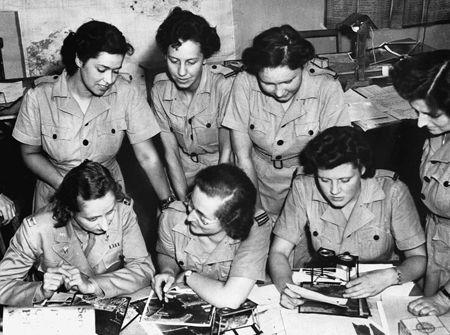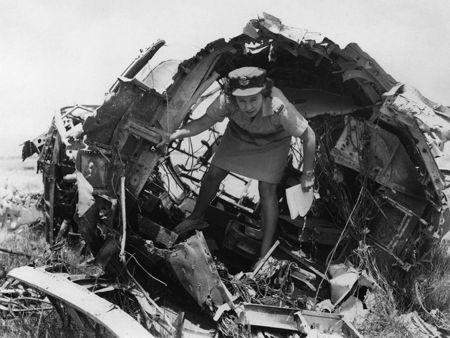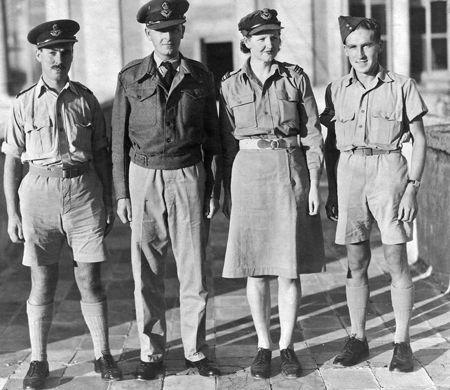Women of Intelligence: Winning the Second World War with Air Photos (35 page)
Read Women of Intelligence: Winning the Second World War with Air Photos Online
Authors: Christine Halsall

At the beginning of 1943 in England, WAAF PIs were being interviewed for their suitability for posting to North Africa. Hazel Furney:
A contingent of interpreters was destined to go there and that included ten of us WAAF. We were all interviewed at the Air Ministry. I was chosen as they needed an ‘L’ Section (Aircraft) person. We knew the WAAF interpreters already in Cairo had a slightly dizzy reputation, so we all went looking as frumpy as we could with our hair tucked up, caps pulled down. They weren’t, in fact, too keen on Suzie and me as we were too young. However, they were persuaded that we were needed, so to our joy we were all off. Of course, we couldn’t say where we were going, just as we could never tell anyone what we did.
One lovely Spring day, my mother, sister-in-law and her two children came down to Medmenham with a picnic, which we had on the river bank. My mother said, ‘You’ll remember this lovely English scene when you’re somewhere hot and dry’. What she didn’t know, and nor did I, was that when I got back to Medmenham, it was all go; five of us were flying out from Benson that evening in an American Flying Fortress. We landed in Cornwall and were given beds until dawn and then we were off on our great adventure.
We flew to Gibraltar, not a luxury flight, no seats, but I found a lovely ledge in the nose where the navigator was, and lay there. The landing was sensational; flying in on my stomach.
Gibraltar was an exciting place. There were hundreds of aircraft there, bombers, fighters and transport as well as naval ships. We were taken in Jeeps to the Rock Hotel for lunch and gasped at the sight of stalls selling oranges, lemons and bananas along the way, things we hadn’t seen for ages. We had a drink with the crew, then lunch when, before the dessert, which was a lovely chocolate confection, they told us our transport had arrived. Ann Whiteman, who was our senior officer and an Oxford don, marched us all out, leaving the crew, who were in no hurry. We found it hard to forgive that, after so much rationed food!
3
They flew on to Algiers, with pavement cafés and shops to enjoy, but perhaps the best sight of all was the Eighth Army soldiers, khaki shirts and shorts bleached white by the desert sun, triumphant after their victory at El Alamein. The five WAAFs were much feted and photographed by the Eighth Army News as the first servicewomen to arrive there. A WAAF officer had been sent ahead to arrange accommodation for them but had failed to do so:
We were put temporarily into a rather sleazy hotel near the Souk – Lothian Nicholas complained that cockroaches were trying to eat her gas mask, which we all carried everywhere, and they had kept her awake. Peggy Thorpe and I, returning from work late at night, walked into our room to be greeted with a cry of ‘Ahha’ from a Frenchman who was in bed! We finally moved to a villa above Algiers.
Suzie Morrison’s first application to go overseas had been turned down because her ‘hair was too long and her skirt too short’. However, after an expensive hair-do before her second interview, she was accepted and flew out to Algiers with the second group of WAAFs on 27 May 1943, again landing at Gibraltar for refuelling and breakfast, when they ‘gorged themselves on the bowls of oranges in the Mess’
.
Their arrival in Algiers brought the WAAF PI numbers to ten and included Dorothy Lygon from the Night Photography Section, Celia MacDonald from Industry, Vera Marsden from Wireless and Radar and Angus Wilson from Damage Assessment.

WAAF PIs in La Marsa, Tunisia, explain their work to an American visitor, sitting next to Anne Whiteman and Suzie Morgan. Standing from left: Hazel Furney, Peggy Thorpe, Lothian Nicholas and Sibeal Maguire.
They were based at an Anglo-American unit, the North African Central Interpretation Unit, at Maison Blanche, near Algiers, where the US president’s son, Colonel Elliott Roosevelt, was the commanding officer. It was agreed by those PIs who worked with both the president’s son and Sarah Churchill, the Prime Minister’s daughter, at various times during the war, that the latter displayed all the positive qualities expected of a leader’s offspring, while the former did not.
The PIs worked at night after the flights had landed and the films had been processed. Suzie worked on Second Phase and Hazel on aircraft identification, as at Medmenham. Breakfast at 3 a.m. was American style and they got used to being served sausages and bacon with maple syrup, probably making a pleasant change from the night-time fare offered at Medmenham.
A few weeks later the group moved eastwards to La Marsa, near Carthage in Tunisia, where they lived in a convent; the males at one end of the building and seven nuns at the other, with the WAAFs in former nuns’ cells above them. They worked in a nearby seminary, where Hazel found a page of a German aircraft recognition book, showing all aspects of Spitfires, left behind by a hastily retreating enemy PI. The unit experienced extremes of climate, from heavy snowfalls to a sirocco when the heat was so great that the photographs rolled up as they tried to interpret them. The flying forces at La Marsa became more international during 1943, when 60 Squadron South African Air Force joined the RAF’s 682 Squadron, which included Canadians, Australians and New Zealanders as well as Polish and Czechoslovak pilots; American and French squadrons were based nearby. Although there were parties to celebrate the capitulation of the Italian forces on 8 September, the intensity of work for the invasion of Sicily and mainland Italy meant that the PIs rarely got time off:
Life was pretty spartan, we never had hot water and the food was not great, but there was a hotel in Tunis we could use to dine and dance. We hitched everywhere, not a problem due to the ten of us being the only females around. We swam in the sea a lot and occasionally went to the local Turkish Baths, which was very entertaining – men in the morning and women in the afternoon – who did all their washing of clothes, babies etc while there.
We were visited by Air Marshal Tedder, General Alexander and President Roosevelt. Churchill came on his way back from Teheran; he had pneumonia and was not seen but Sarah came to visit us.
4
In December 1943 the WAAFs were flown in Mitchell bombers to San Severo, in Apulia, southern Italy, the HQ of 336 PR Wing, landing at one of the eleven satellite airfields of Foggia, recently captured by the Eighth Army. Hazel had discovered the tenth of these airfields on photographs she had analysed at La Marsa, and by coincidence it happened to be the one on which they landed. In fact, the PIs knew all the details of the town of Foggia, as well as many other areas, having provided detailed targeting information for air crews. They also assessed the extent of post-raid bomb damage and provided tactical information for advancing Allied forces. Hazel was an expert on aircraft recognition, and found it particularly interesting at Foggia Airfield to climb inside the wreckage of some of the German planes, which she had identified earlier on photographs.

Hazel Furney, who worked in the Aircraft Section, investigates a crashed German aircraft at Foggia Airfield, southern Italy.
Forty miles north of San Severo, the Allied forces were encountering enemy resistance and the PIs worked in their office at a local college to the background sound of gunfire. Hazel and other WAAFs lived in a nearby block of flats where they also had their mess:
One night an officer with a dozen or so Canadian soldiers arrived quite late. He explained that they had been fighting non-stop for two days and could they come in to sleep on the floor until morning. I went to make some tea, and when I came back they were all flat out in their sleeping bags on the floor – they had been fighting at Ortona.
5
The town’s opera house became an officers’ club, where they danced in the evenings to a gramophone or an occasional band, and once an operatic company came from Naples to perform
Rigoletto
. The WAAFs were never short of escorts from the PR squadrons for dances and visits to restaurants, where they were warmly welcomed by the local Italian population. Despite these pleasant interludes, the harsh realities of war were always apparent to them in the number of aircraft losses and the many casualties. Mosquito aircraft at San Severo had enough range to reach Poland and Romania to photograph the synthetic oil plants and underground factories, so they worked all hours. Hazel wrote:
Once we had stopped the Italian cook flogging our rations and serving us very poor quality pasta, we fed better but still no hot water – just lots of cockroaches in the bathroom. We slept three or four to a room on camp beds, lined with layers of newspaper to keep us warm. We got airmen’s woollen vests to augment our pyjamas and we all took to wearing an odd assortment of clothes in place of uniform.

Dorothy Lygon, ‘Coote’, with the Night Photography Section at San Severo, Italy.
In 1942 Suzie Morrison had been working at RAF Wick, on the north-east coast of Scotland, where she met a PR Spitfire pilot who had just flown in from RAF St Eval. Over lunch she told him that she had interpreted the photographs he had taken of German battleships off the French coast. Their next chance meeting was at a dance in Algiers and after a whirlwind courtship, Suzie was married on 9 February 1944 to Squadron Leader Jimmy Morgan DSO, the commanding officer of 682 PR Squadron based at an airfield near San Severo. Suzie wrote:
I had to ask permission to marry from my Commanding Officer, Group Captain Fuller, as it was the first Allied wedding in Italy. He then sent a signal to the Commander in Chief Air Headquarters at Caserta, who replied, ‘Permission granted provided it is not brought to my notice.’ That meant that I did not apply for a marriage allowance, and carried on with my duties as usual. I did, however, have to alter my marriage licence from age 21 to 20, as I had added a year on to my age when I joined up in 1940.
6
Their marriage took place in the opera house and Suzie managed to find enough material locally and a dressmaker to make her own dress and four pale-blue ones for the bridesmaids. She even arranged for a traditional iced wedding cake, suitably adorned with a model Spitfire, to be served to the guests. Their CO, Colonel Roosevelt, let one of his pilots fly the newly weds in a P-38 Lightning for a four-day honeymoon in Malta. Suzie wrote: